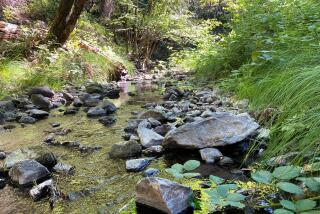Savoring a Dam Decision
There are a couple of distinguishing characteristics of dams aside from their ability to store water, stop floods and generate power. Dams are relatively easy to put up once it has been established that the availability of water and power is important enough to outweigh the environmental damage a dam might cause by flooding valued valleys or changing the nature of life downstream. They also are notoriously hard to tear down if it turns out that the calculations of economic benefits and environmental losses were wrong.
California has had experience with such miscalculation, a prime example being the New Melones dam on the Stanislaus River that provides very cheap power for a small number of Californians at the cost of an irreplaceable recreation area in the Sierra Nevada foothills, uniquely within reach of major urban areas, that was quietly drowned by the dam. Fortunately, people often learn from such mistakes, as demonstrated by rules written into the Clean Water Act after New Melones was built, rules that are holding up the proposed Two Forks dam and reservoir project southwest of Denver, Colo., so-called because the dam would rise 615 feet above the foot of the Rocky Mountains where the South Platte River and its north fork join.
The rules give the federal Environmental Protection Agency veto power over projects that it decides will cause a “significant loss” of riparian environment. In the first of three steps necessary to kill such a project, EPA Administrator William K. Reilly served notice in March that he was considering a veto, that being all it took to suspend work on Two Forks. The second step also has been completed, a review of the project by a senior EPA official, who concluded on Tuesday, after some months of study, that Two Forks would destroy one of the best fishing and recreation areas left in the western United States. Two or more months of public hearings now will be held on the judgment by Lee A. DeHihns, deputy regional director of EPA operations of Atlanta, who was sent into Denver to take a look.
It would not be what is billed as Colorado’s “last big water war” if supporters of Two Forks just folded, and they show no signs of that. One of their mild reactions was that they didn’t want a carpetbagger telling them where to get water. Denver Mayor Frederico F. Pena called EPA’s latest report a flawed document, and said the least the agency owed Denver was an alternative plan that would tell them where their water might come from.
Denver’s Environmental Caucus is sure to testify during public hearings, since it has contended in the past that estimates of water demand in the Denver area are exaggerated, that water can be bought from farmers and produced from other, cheaper projects or that supplies can be stretched out by conservation. It seems likely also that environmentalists will mention that Two Forks would store up to 1.1-million acre-feet of water, about twice what the city of Los Angeles uses in a year, as a hedge against disruption of existing supply. One form, they say in Denver, that disruption might take would be a raid on Colorado River water by California.
So far, the EPA seems satisfied that the environmentalists have the best of the argument. It looks that way to us, too, although no final decision is due until late this year, after public hearings--or perhaps until early next year. But at this point we are willing to savor the fact that the case for erring on the side of saving what is left of the true character of the western United States is getting a fair hearing, that the notorious difficulty of unbuilding a dam is getting equal time with the relative ease of building one.
More to Read
Sign up for Essential California
The most important California stories and recommendations in your inbox every morning.
You may occasionally receive promotional content from the Los Angeles Times.










